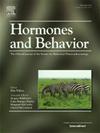Neural connectivity of oxytocin receptor-expressing neurons in the nucleus accumbens and their role in social attachment
IF 2.5
3区 医学
Q2 BEHAVIORAL SCIENCES
引用次数: 0
Abstract
Oxytocin receptor (OXTR) activity in the nucleus accumbens (NAc) is critical for pair bonding in prairie voles. Oxtr knockdown or pharmacological blockade in this region prevents mating-induced partner preferences, while overexpression facilitates bonding. However, no prior work has selectively interrogated or manipulated Oxtr-expressing neurons during dynamic bonding behaviors. We have developed an Oxtr-P2A-Cre prairie vole line that enables direct access to specific Oxtr neural populations. We utilized Oxtr-P2A-Cre prairie voles to express inhibitory DREADDs selectively in OXTR-expressing NAc neurons. Inhibiting NAc OXTR cells during initial cohabitation did not affect subsequent partner preference formation; however, inhibition during partner preference testing increased partner-directed huddling behavior, revealing a complex role for these neurons in social interactions. Using a viral tracing approach, we found that NAc OXTR-expressing neurons receive prominent inputs from the medial prefrontal cortex, hippocampus, thalamus, and hypothalamus, while projecting strongly to the ventral pallidum, ventral tegmental area, and lateral hypothalamus. Our cell-type-specific manipulation reveals how oxytocin receptor signaling in the NAc may modulate emotional state and facilitate the complex social behaviors underlying monogamous pair bonding. This Cre-recombinase approach demonstrates the utility of cell-type-specific targeting for elucidating oxytocin neural circuit mechanisms regulating emotional and social behavior in prairie voles.
伏隔核中催产素受体表达神经元的神经连通性及其在社会依恋中的作用
草原田鼠伏隔核(NAc)中催产素受体(OXTR)的活性对配对关系至关重要。该区域的Oxtr敲低或药物阻断阻止了交配诱导的伴侣偏好,而过表达则促进了结合。然而,在动态键合行为中,没有先前的工作选择性地询问或操纵表达oxr的神经元。我们已经开发了Oxtr- p2a - cre草原田鼠系,可以直接访问特定的Oxtr神经种群。我们利用Oxtr-P2A-Cre草原田鼠在表达oxtr -的NAc神经元中选择性表达抑制性DREADDs。抑制NAc OXTR细胞在初始同居期间不影响随后的伴侣偏好形成;然而,在伴侣偏好测试中的抑制增加了伴侣导向的抱团行为,揭示了这些神经元在社会互动中的复杂作用。利用病毒追踪方法,我们发现表达NAc oxtr的神经元接受来自内侧前额叶皮层、海马、丘脑和下丘脑的显著输入,同时强烈地投射到腹侧白球、腹侧被盖区和外侧下丘脑。我们的细胞类型特异性操作揭示了NAc中的催产素受体信号如何调节情绪状态并促进一夫一妻制伴侣结合的复杂社会行为。这种Cre-recombinase方法证明了细胞类型特异性靶向在阐明草原田鼠调节情绪和社会行为的催产素神经回路机制方面的效用。
本文章由计算机程序翻译,如有差异,请以英文原文为准。
求助全文
约1分钟内获得全文
求助全文
来源期刊

Hormones and Behavior
医学-行为科学
CiteScore
6.70
自引率
8.60%
发文量
139
审稿时长
91 days
期刊介绍:
Hormones and Behavior publishes original research articles, reviews and special issues concerning hormone-brain-behavior relationships, broadly defined. The journal''s scope ranges from laboratory and field studies concerning neuroendocrine as well as endocrine mechanisms controlling the development or adult expression of behavior to studies concerning the environmental control and evolutionary significance of hormone-behavior relationships. The journal welcomes studies conducted on species ranging from invertebrates to mammals, including humans.
 求助内容:
求助内容: 应助结果提醒方式:
应助结果提醒方式:


